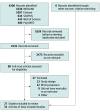Mortality in Persons With Autism Spectrum Disorder or Attention-Deficit/Hyperactivity Disorder: A Systematic Review and Meta-analysis
- PMID: 35157020
- PMCID: PMC8845021
- DOI: 10.1001/jamapediatrics.2021.6401
Mortality in Persons With Autism Spectrum Disorder or Attention-Deficit/Hyperactivity Disorder: A Systematic Review and Meta-analysis
Abstract
Importance: Autism spectrum disorder (ASD) and attention-deficit/hyperactivity disorder (ADHD) are childhood-onset disorders that may persist into adulthood. Several studies have suggested that they may be associated with an increased risk of mortality; however, the results are inconsistent.
Objective: To assess the risk of mortality among persons with ASD or ADHD and their first-degree relatives.
Data sources: A search of MEDLINE, Embase, Scopus, Web of Science, and PsycINFO (published from inception to April 1, 2021) was supplemented by searching reference lists of the retrieved articles.
Study selection: Cohort and case-control studies that reported mortality rate ratios (RRs) in persons with ASD or ADHD and/or their first-degree relatives compared with the general population or those without ASD/ADHD were included.
Data extraction and synthesis: Screening, data extraction, and quality assessment were performed by at least 2 researchers independently. A random-effects model was used to meta-analyze individual studies and assessed heterogeneity (I2).
Main outcomes and measures: All-cause mortality in association with ASD or ADHD. Secondary outcome was cause-specific mortality.
Results: Twenty-seven studies were included, with a total of 642 260 individuals. All-cause mortality was found to be higher for persons with ASD (154 238 participants; 12 studies; RR, 2.37; 95% CI, 1.97-2.85; I2, 89%; moderate confidence) and persons with ADHD (396 488 participants; 8 studies; RR, 2.13; 95% CI, 1.13-4.02; I2, 98%; low confidence) than for the general population. Among persons with ASD, deaths from natural causes (4 studies; RR, 3.80; 95% CI, 2.06-7.01; I2, 96%; low confidence) and deaths from unnatural causes were increased (6 studies; RR, 2.50; 95% CI, 1.49-4.18; I2, 95%; low confidence). Among persons with ADHD, deaths from natural causes were not significantly increased (4 studies; RR, 1.62; 95% CI, 0.89-2.96; I2, 88%; low confidence), but deaths from unnatural causes were higher than expected (10 studies; RR, 2.81; 95% CI, 1.73-4.55; I2, 92%; low confidence).
Conclusions and relevance: This systematic review and meta-analysis found that ASD and ADHD are associated with a significantly increased risk of mortality. Understanding the mechanisms of these associations may lead to targeted strategies to prevent avoidable deaths in high-risk groups. The substantial heterogeneity between studies should be explored further.
Conflict of interest statement
Figures



Comment in
-
Higher Risk of Mortality for Individuals Diagnosed With Autism Spectrum Disorder or Attention-Deficit/Hyperactivity Disorder Demands a Public Health Prevention Strategy.JAMA Pediatr. 2022 Apr 1;176(4):e216398. doi: 10.1001/jamapediatrics.2021.6398. Epub 2022 Apr 4. JAMA Pediatr. 2022. PMID: 35157011 Free PMC article. No abstract available.
References
-
- Kassebaum N, Kyu HH, Zoeckler L, et al. ; Global Burden of Disease Child and Adolescent Health Collaboration . Child and adolescent health from 1990 to 2015: findings from the Global Burden of Diseases, Injuries, and Risk Factors 2015 Study. JAMA Pediatr. 2017;171(6):573-592. doi:10.1001/jamapediatrics.2017.0250 - DOI - PMC - PubMed
Publication types
MeSH terms
LinkOut - more resources
Full Text Sources
Medical
Miscellaneous

